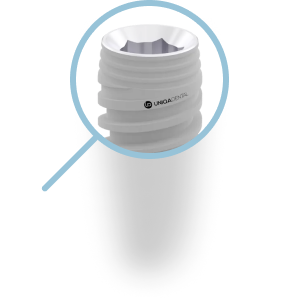Drilling procedure for UNIQA Dental Pure & Porous Implant UH8 UV11 [ 3.3 mm | D1 bone density ]
Video description of the drilling protocol
IMPORTANT! Before installing Uniqa Dental implants, it is necessary to familiarize yourself with the protocol for preparing the implant site. The video shows the sequence of operations for installing a 3.3 mm diameter implant in dense D1 bone.
First, a hole should be made in the hardest cortical layer of the bone to a depth of 1-2 mm using a special cortical bone drill. Next, use a 2 mm diameter pilot drill to make the hole to full depth, typically up to 10 mm. The recommended rotational speed is 1000 rpm, maximum 1200 rpm. Drilling should be done with moderate pressure to avoid feeling resistance from the bone. Intensive irrigation is necessary to cool the drill and surrounding bone.
Next, use a 2.5 mm diameter drill to go halfway into the future implant site. A 2.8 mm diameter drill can be used to go a quarter of the way into the site. Then, use a 3.2 mm drill to expand the opening of the site to the depth of the cortical bone layer, typically 2-2.2 mm. If there is resistance from the bone during drilling, it may be necessary to replace the drill as the one being used may have become dull.
Under no circumstances should drilling be done without water, as this can overheat the bone and lead to thermal necrosis of the bone tissue after implant installation.
Insert the implant into the prepared site. The aggressive thread profile of Uniqa Dental implants allows it to be screwed directly into the bone tissue, providing good primary stability. The maximum allowable torque when installing the implant is 50 N*cm. Carefully follow the instructions provided.



![Drilling procedure for UNIQA Dental Pure & Porous Implant UH8 UV11 [ 3.3 mm | D2-D3 bone density ]](https://img.youtube.com/vi/mlw4vHRaPvc/maxresdefault.jpg)



